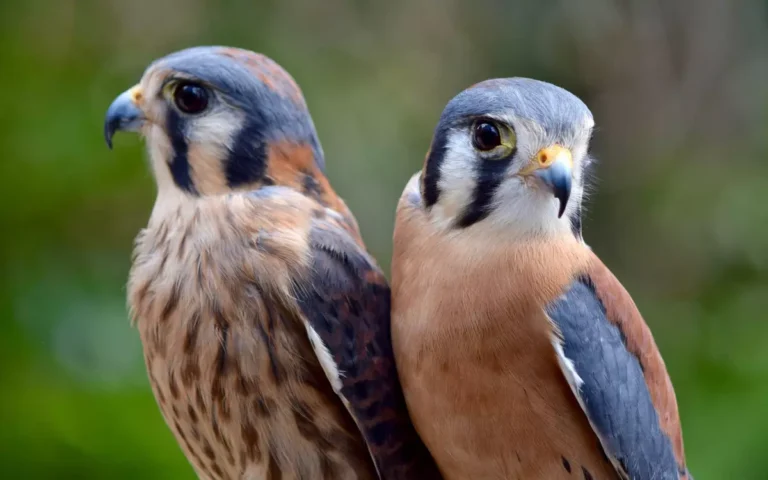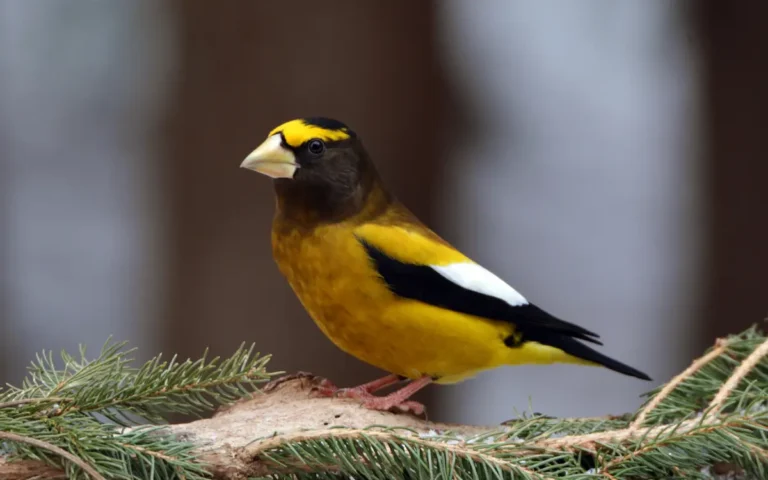26 Species of Sparrows in California You can see

Welcome to the colorful little birds world of the sparrows of California! These charming birds are key players in their habitats, showcasing many types of species each adapted to different environments across the state.
26 Species of Sparrows in California
1. California Towhee:

The California Towhee, with its warm brown plumage and distinctive red eye, is a common sight in gardens and shrubby areas across the state. These ground-dwelling sparrows have a melodious yet simple song that fills the air during early mornings.
Habitat and Behavior
California Towhees are known for their preference for dense undergrowth and shrubbery. They forage on the ground, scratching and pecking for insects, seeds, and fruits. These birds are often spotted hopping around leaf litter in search of their next meal.
Interesting Fact
Did you know that California Towhees are excellent at creating hidden nests on the ground, blending seamlessly with their surroundings?
- Length: 8.3-9.8 in (21-25 cm)
- Weight: 1.3-2.4 oz (37-67 g)
- Wingspan: 11.4 in (29 cm)
2. Savannah Sparrow:

With its intricate brown and white markings, the Savannah Sparrow is a master of camouflage in grassy habitats. Their sweet and soft song adds a delightful touch to open meadows and coastal areas.
Habitat and Behavior
Savannah Sparrows are renowned for their habitat flexibility, being found in grasslands, meadows, and even coastal dunes. They feed on seeds, insects, and berries, often foraging on the ground or perched atop grass stalks.
Interesting Fact
Savannah Sparrows undertake an incredible migratory journey, breeding in North America during the summer and wintering as far south as Central America.
- Length: 4.7-6.7 in (12-17 cm)
- Weight: 0.4-1.9 oz (12-53 g)
- Wingspan: 7.1-9.4 in (18-24 cm)
3. Golden-crowned Sparrow:
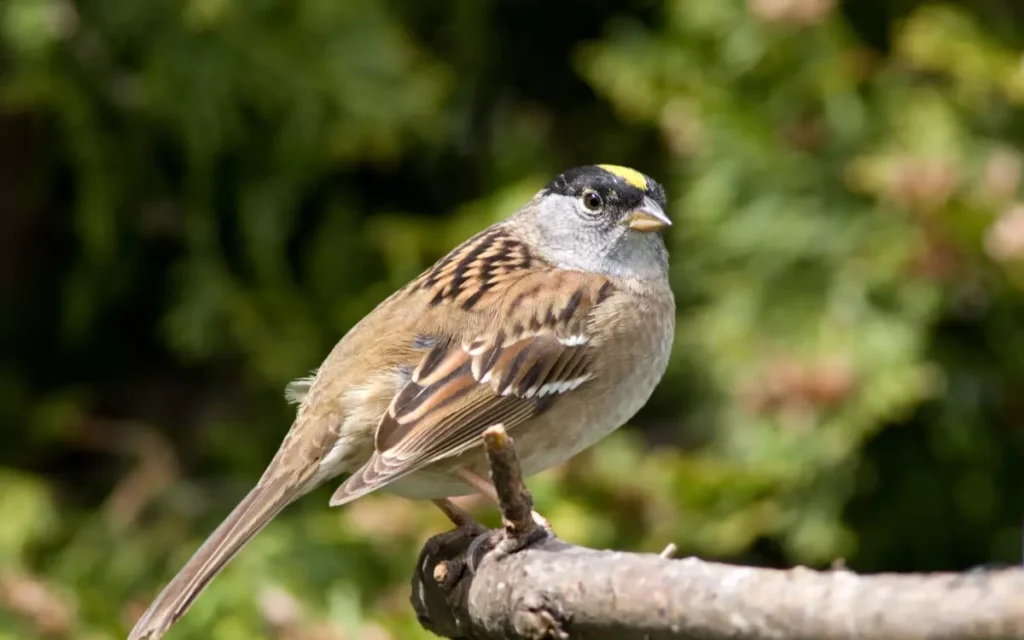
The distinctive yellow crown marking of the Golden-crowned Sparrow makes it stand out in a crowd. Its melancholic song, often described as a series of three mournful whistles, is a beautiful addition to California’s bird chorus.
Habitat and Behavior
Golden-crowned Sparrows are found in shrublands, woodlands, and even urban gardens. They have a varied diet, feeding on seeds, insects, and fruits. These sparrows are known for their synchronized group movements during migration.
Interesting Fact
During the winter months, the Golden-crowned Sparrow’s diet changes, and they become more reliant on berries and fruits due to the scarcity of insects.
- Length: 5.9-7.1 in (15-18 cm)
- Weight: 1.1-1.2 oz (30-33 g)
- Wingspan: 9.74 in (24.75 cm)
4. White-crowned Sparrow:
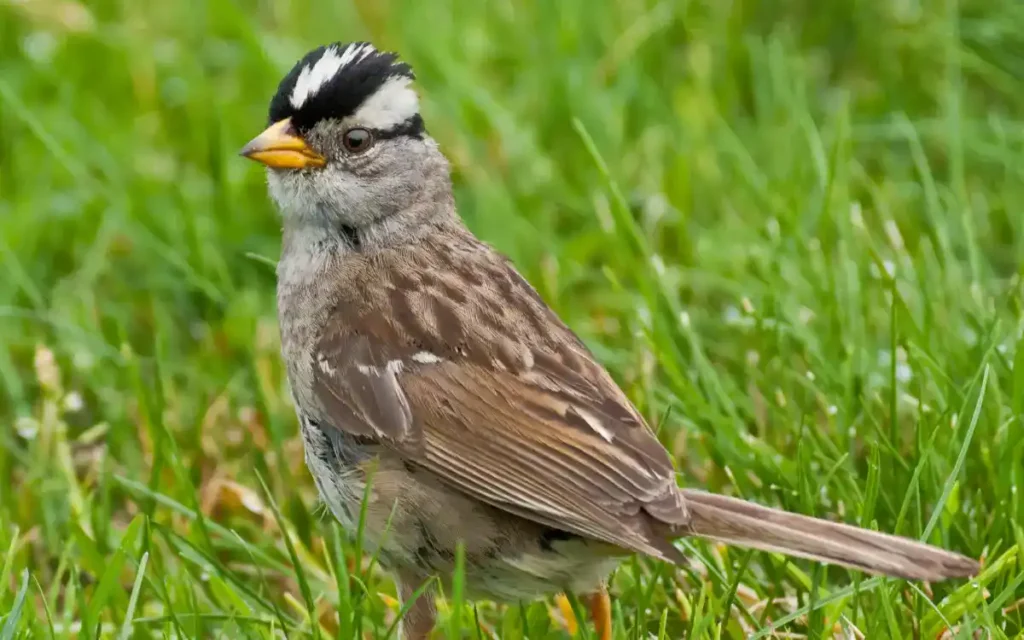
With striking black and white stripes on its head, the White-crowned Sparrow is a true avian gem. Their clear, melodious song is often compared to a whistled tune, adding a cheerful note to their surroundings.
Habitat and Behavior
White-crowned Sparrows are adaptable, thriving in a range of habitats from shrublands to coastal areas. Their diet consists of seeds, insects, and plant matter. These sparrows are known for their distinct regional dialects in their songs.
Interesting Fact
The White-crowned Sparrow’s song is not only beautiful but also serves as a crucial tool for identifying individuals and establishing territories.
- Length: 5.9-6.3 in (15-16 cm)
- Weight: 0.9-1.0 oz (25-28 g)
- Wingspan: 8.3-9.4 in (21-24 cm)
5. Song Sparrow:

The Song Sparrow lives up to its name with a vibrant and complex song that varies between individuals. Its streaked brown plumage and charismatic personality make it a cherished member of the Californian avian community.
Habitat and Behavior
Song Sparrows are versatile birds found in a wide range of habitats, from wetlands to urban parks. Their diet includes seeds, insects, and small invertebrates. These sparrows are known for their elaborate courtship displays.
Interesting Fact
Each male Song Sparrow has a unique song that he creates by combining different elements from other nearby sparrows’ songs, resulting in a distinct melody.
- Length: 4.7-6.7 in (12-17 cm)
- Weight: 0.4-1.9 oz (12-53 g)
- Wingspan: 7.1-9.4 in (18-24 cm)
6. Fox Sparrow:

The Fox Sparrow’s richly colored plumage, ranging from rusty red to warm brown, is a sight to behold. Its song, often described as a series of clear, musical phrases, adds a touch of magic to its woodland habitat.
Habitat and Behavior
Fox Sparrows prefer dense undergrowth and forested areas, where they forage for seeds, insects, and berries. Their distinctive scratching behavior while foraging can reveal their presence even before they are seen.
Interesting Fact
There are several distinct subspecies of Fox Sparrows, each with slightly different plumage variations, making them a subject of fascination for bird enthusiasts.
- Length: 5.9-7.5 in (15-19 cm)
- Weight: 0.9-1.6 oz (26-44 g)
- Wingspan: 10.5-11.4 in (26.7-29 cm)
7. Dark-eyed Junco:

The Dark-eyed Junco is known for its diverse plumage variations, with different regional populations sporting various color patterns. Its trilling song and frequent presence at bird feeders make it a cherished sight in backyards.
Habitat and Behavior
Dark-eyed Juncos inhabit a range of environments, from forests to suburban areas. They primarily feed on seeds and insects. These sparrows are known for their distinctive “twitching” tail movements.
Interesting Fact
Dark-eyed Juncos have a remarkable ability to survive harsh winters, often seeking shelter in brush piles or dense vegetation to stay warm.
- Length: 5.5-6.3 in (14-16 cm)
- Weight: 0.6-1.1 oz (18-30 g)
- Wingspan: 7.1-9.8 in (18-25 cm)
8. Chipping Sparrow:
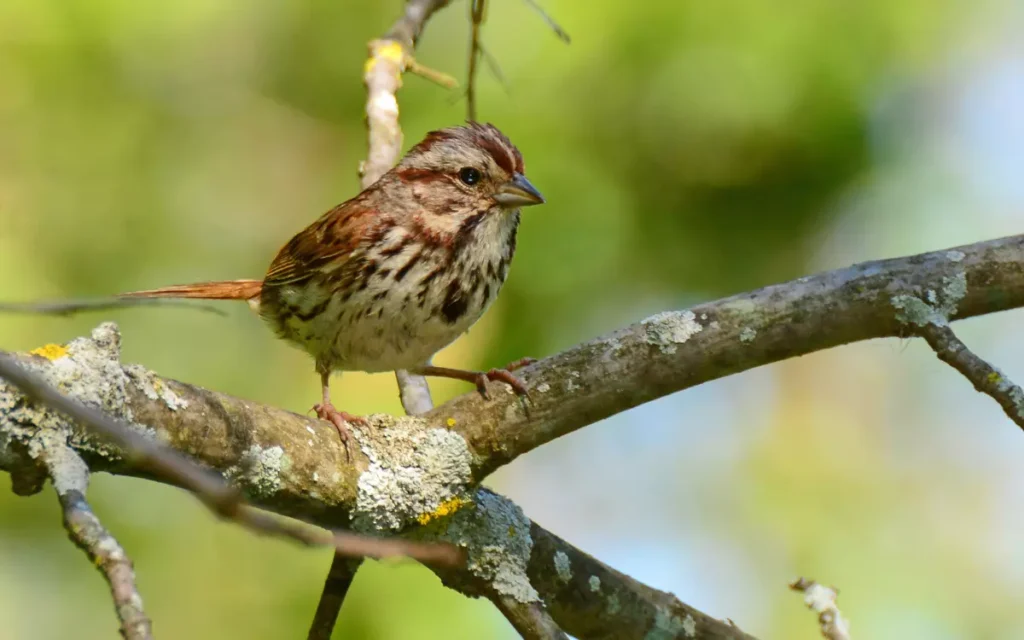
With its crisp markings and distinct rufous crown, the Chipping Sparrow is a delightful addition to gardens and open woodlands. Its cheerful and rhythmic song resembles the sound of a sewing machine.
Habitat and Behavior
Chipping Sparrows are often found in grassy areas, gardens, and open forests. They feed on a varied diet of seeds, insects, and small fruits. These sparrows are known for their energetic foraging behavior.
Interesting Fact
Chipping Sparrows are known to engage in “anting,” a behavior where they rub ants on their feathers, possibly to benefit from the ants’ defensive chemicals.
- Length: 4.7-5.9 in (12-15 cm)
- Weight: 0.4-0.6 oz (11-16 g)
- Wingspan: 8.3 in (21 cm)
9. Lark Sparrow:

Lark Sparrows stand out with their intricate facial markings and striking appearance. Their lovely, melodious song, reminiscent of a tinkling music box, adds an enchanting element to grassy fields and open habitats.
Habitat and Behavior
Lark Sparrows are often seen in grasslands, open fields, and scrubby areas. They have a varied diet that includes seeds, insects, and small invertebrates. These sparrows are known for their ground-foraging habits.
Interesting Fact
Lark Sparrows build elaborate nests, often incorporating bits of colorful debris, which may help attract a mate.
- Length: 5.9-6.7 in (15-17 cm)
- Weight: 0.8-1.2 oz (24-33 g)
- Wingspan: 11.0 in (28 cm)
10. Brewer’s Sparrow:
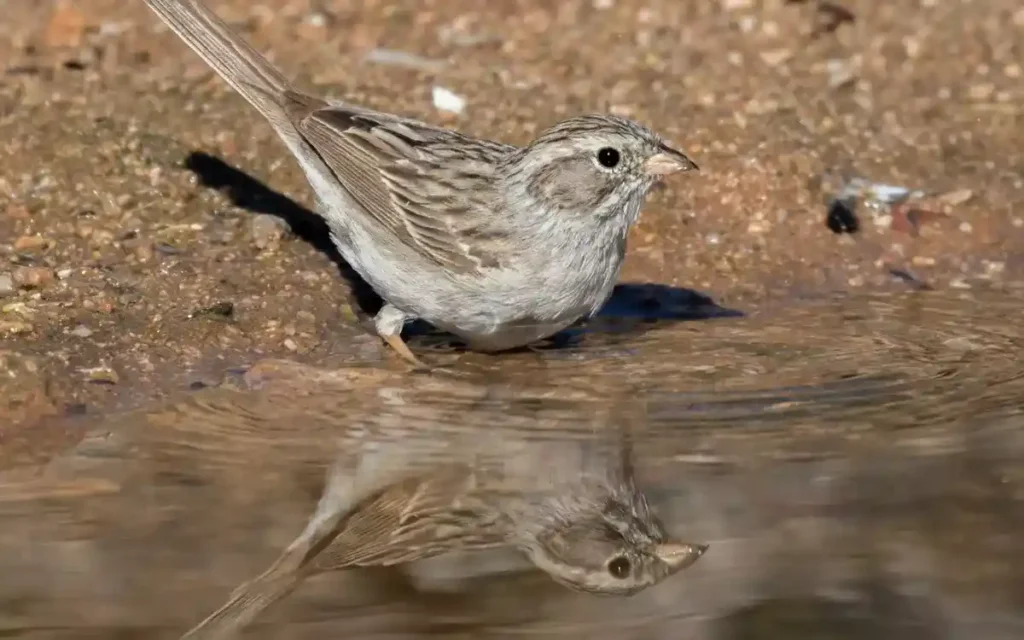
The subtle yet charming appearance of Brewer’s Sparrow features soft gray plumage and a distinctive eye ring. Their subdued song, often described as a series of tinkling notes, is a soothing sound in arid habitats.
Habitat and Behavior
Brewer’s Sparrows are primarily found in sagebrush habitats and arid landscapes. They feed on seeds and insects, often foraging in low vegetation and shrubs. These sparrows are known for their quiet and unassuming nature.
Interesting Fact
Brewer’s Sparrows are highly adapted to desert life, with specialized behaviors that help them conserve water in harsh environments.
- Length: 5.1-5.9 in (13-15 cm)
- Weight: 0.4-0.5 oz (11-14 g)
- Wingspan: 7.1-7.9 in (18-20 cm)
11. Vesper Sparrow:
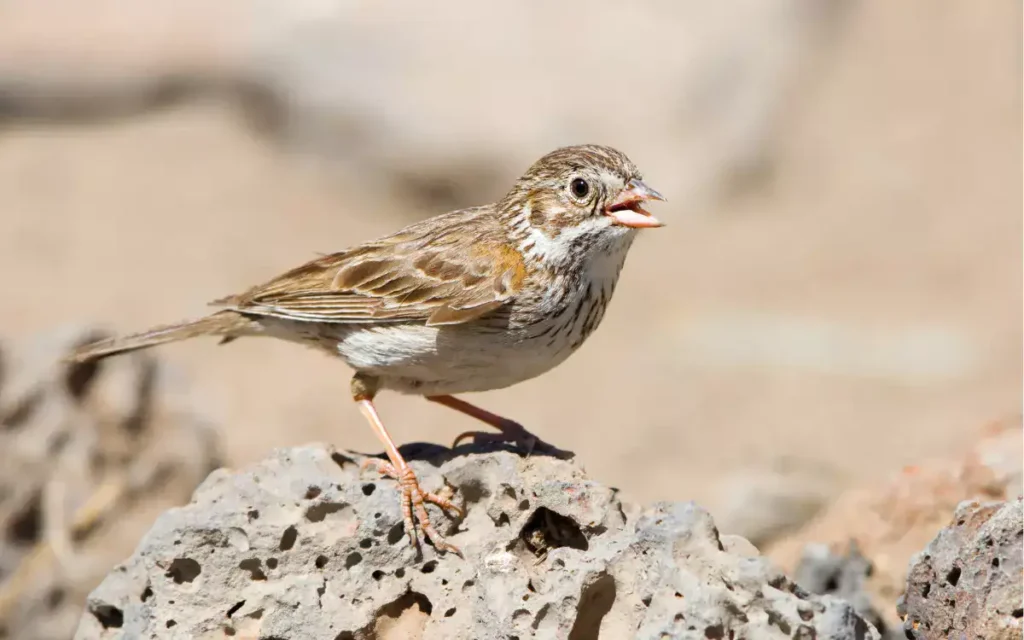
The Vesper Sparrow boasts a lovely combination of white outer tail feathers and a distinct eye ring. Its song, heard during the evening hours, is a peaceful and tranquil melody that graces grasslands and agricultural fields.
Habitat and Behavior
Vesper Sparrows inhabit grassy fields, pastures, and prairies. Their diet consists of seeds, insects, and small invertebrates. These sparrows are known for their crepuscular singing behavior.
Interesting Fact
Vesper Sparrows often incorporate snake skin in their nests, which may serve as a deterrent against nest predators.
- Length: 5.1-6.3 in (13-16 cm)
- Weight: 0.7-1.0 oz (20-28 g)
- Wingspan: 9.4 in (24 cm)
12. Sagebrush Sparrow:

The Sagebrush Sparrow is aptly named for its affinity for sagebrush habitats. With its subtle gray plumage and fine streaking, it blends seamlessly with its arid surroundings. Its song, often described as a series of soft buzzes, echoes through the sagebrush.
Habitat and Behavior
Sagebrush Sparrows are closely associated with sagebrush ecosystems. They feed on insects, seeds, and plant matter, often foraging low to the ground. These sparrows are known for their distinctive courtship displays.
Interesting Fact
Sagebrush Sparrows are skilled at finding sheltered spots within sagebrush plants to build their nests, helping protect their young from harsh weather and predators.
- Length: 6.25 in(16 cm )
- Weight: 0.7 oz(20 g)
- Wingspan: 8.25 in (21 cm)
13. Grasshopper Sparrow:

The Grasshopper Sparrow stands out with its intricate and fine streaking on its plumage. Its distinct song, characterized by a series of buzzy and insect-like notes, adds an element of curiosity to grasslands and meadows.
Habitat and Behavior
Grasshopper Sparrows inhabit grassy areas, prairies, and pastures. They feed on insects, especially grasshoppers, as well as seeds. These sparrows are known for their secretive behavior and propensity to stay hidden in vegetation.
Interesting Fact
The Grasshopper Sparrow’s song is often mistaken for the sound of an actual grasshopper due to its unique buzzing quality.
- Length: 4.3-4.5 in (10.8-11.5 cm)
- Weight: 0.5-0.7 oz (14-20 g)
- Wingspan: 7.9 in (20 cm)
14.Black-throated Sparrow:
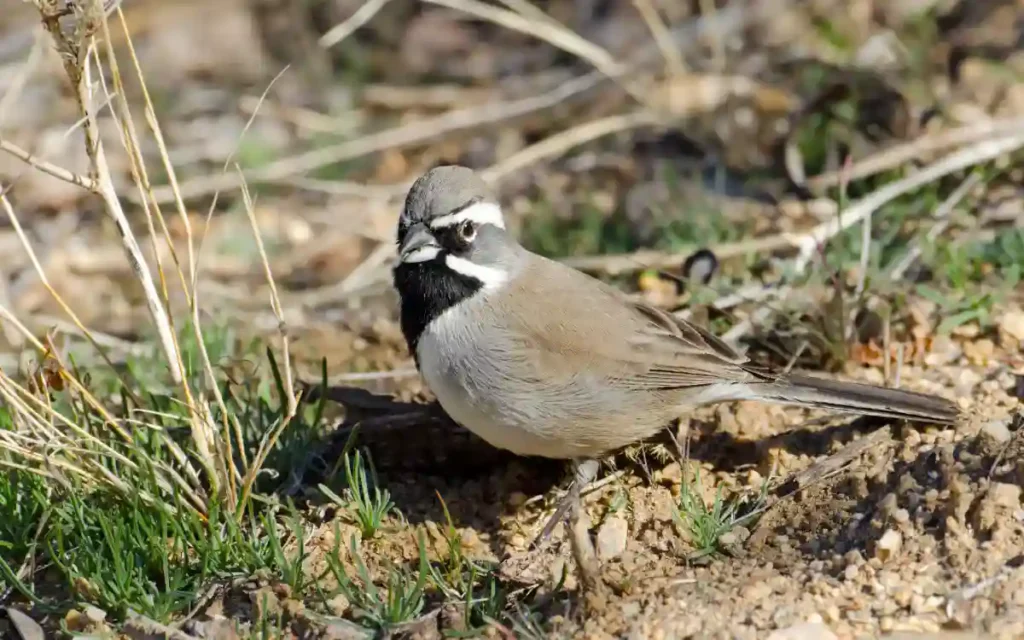
The Black-throated Sparrow boasts a striking black patch on its throat, setting it apart from other sparrows. Its melodious song, a series of clear notes followed by a trill, is a delight to hear in arid habitats.
Habitat and Behavior
Black-throated Sparrows are commonly found in desert scrublands and arid environments. They feed on seeds, insects, and plant matter. These sparrows are known for their habit of singing from elevated perches.
Interesting Fact
Black-throated Sparrows are known for their behavior of “skylarking,” where they ascend into the air and perform a fluttering, descending flight display.
- Length: 4.7-5.5 in (12-14 cm)
- Weight: 0.4-0.5 oz (11-15 g)
- Wingspan: 7.7 in (19.5 cm)
15. Bell’s Sparrow:
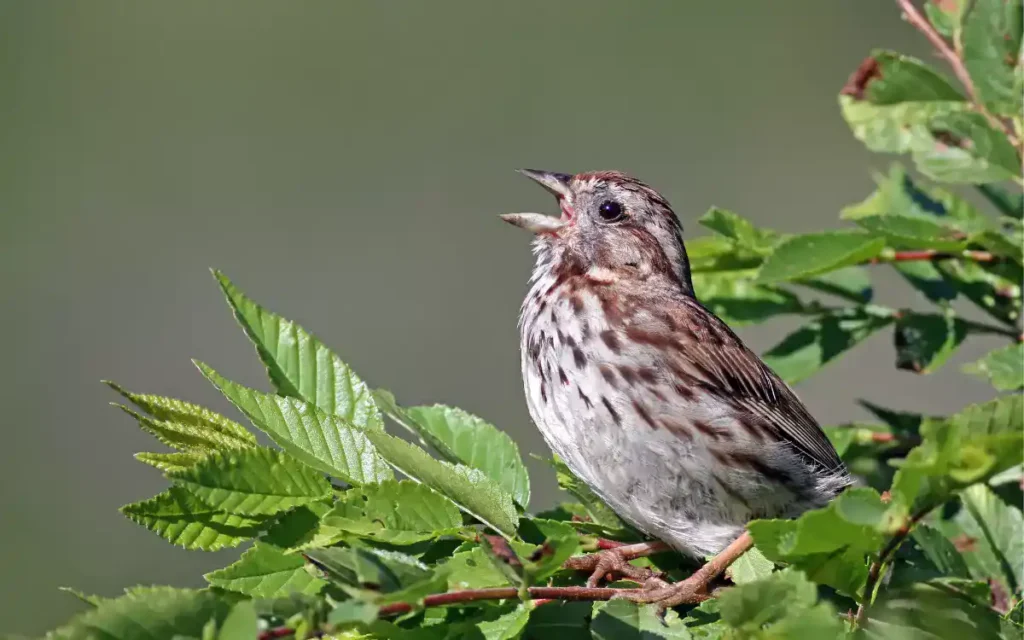
Bell’s Sparrow is a species complex consisting of three distinct subspecies, each with unique plumage characteristics. Their song varies between subspecies, from a soft, musical trill to a clear, melodious tune.
Habitat and Behavior
Bell’s Sparrows are found in arid habitats, including coastal scrublands and desert landscapes. They feed on insects, seeds, and plant matter. These sparrows are known for their affinity for low shrubs and dense vegetation.
Interesting Fact
The subspecies of Bell’s Sparrow were originally considered separate species until recent genetic studies revealed their close relationship.
- Length: 6.25 in (16 cm)
- Weight: 0.7 oz (20 g)
- Wingspan: 8.25 in (21 cm)
Read also:-
- 17 Types Of Woodpeckers In California(Pictures,wingspan,Location)
- 10 unique California Ducks with their Info
16. Black-chinned Sparrow:

The Black-chinned Sparrow boasts a distinctive black chin patch that contrasts beautifully with its gray plumage. Its song, a gentle trill, adds a soothing melody to the rocky canyons and slopes it calls home.
Habitat and Behavior
Black-chinned Sparrows are commonly found in arid and rocky habitats, including chaparral and canyons. They feed on insects, seeds, and plant material. These sparrows are known for their elusive behavior.
Interesting Fact
Black-chinned Sparrows are known for their complex and subtle variations in song, which may help them recognize individuals and establish territories.
- Length: 5.75 in (15 cm)
- Weight: 0.4 oz (11 g)
- Wingspan: 9 in (23 cm)
17. Five-striped Sparrow:

The Five-striped Sparrow stands out with its striking facial markings and distinct five-stripes on its head. Its song, often described as a series of clear whistles, adds an element of intrigue to grasslands and shrubby habitats.
Habitat and Behavior
Five-striped Sparrows are commonly found in dense shrublands and scrubby areas. They feed on insects, seeds, and small invertebrates. These sparrows are known for their elusive nature, often remaining hidden in thick vegetation.
Interesting Fact
The Five-striped Sparrow is one of the most challenging sparrows to spot due to its secretive behavior and preference for dense cover.
- Length: 6 inches
- Weight:around 0.7 oz (20 g)
- Wingspan: 15 cm (6 in)
18. Cassin’s Sparrow:

Cassin’s Sparrow boasts a charming combination of subtle streaks and a warm buffy coloration. Its song, a mix of whistles and trills, is often heard during the breeding season in grasslands and open fields.
Habitat and Behavior
Cassin’s Sparrows are primarily found in grasslands, prairies, and agricultural areas. They feed on insects, seeds, and plant material. These sparrows are known for their habit of singing from elevated perches.
Interesting Fact
Cassin’s Sparrows have a unique courtship behavior called “bouncing,” where they hop from the ground to an elevated perch while singing.
- Length: 5-6 in/13-15 cm
- Weight: 0.6 – 0.7 ounces
- Wingspan: 7.9 inches
19. Rufous-winged Sparrow:

The Rufous-winged Sparrow boasts striking rufous-colored wings and a distinct white eye ring. Its song, characterized by a series of clear notes followed by a trill, adds a melodious touch to desert habitats.
Habitat and Behavior
Rufous-winged Sparrows inhabit arid environments, including desert scrublands and grasslands. They feed on insects, seeds, and small invertebrates. These sparrows are known for their preference for low vegetation.
Interesting Fact
The Rufous-winged Sparrow’s song is often described as a “dry trill,” perfectly suited to its desert home.
- Length: 5.1-5.5 in (13-14 cm)
- Weight: 0.5-0.6 oz (14.1 -17 g)
- Wingspan: Wingspan: 8.3 in (21 cm)
20. American Tree Sparrow:
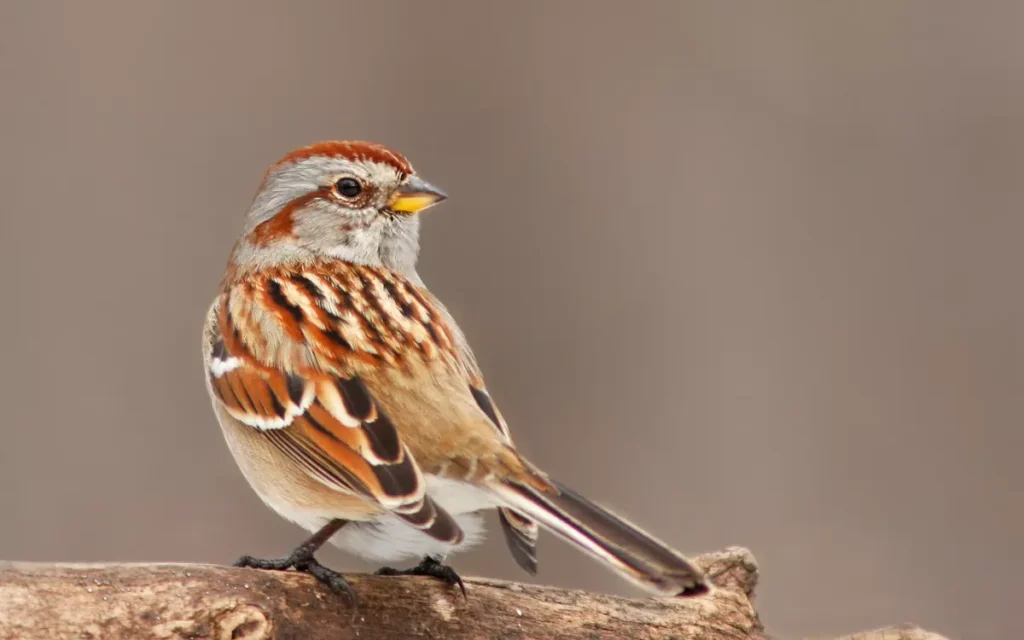
The American Tree Sparrow boasts a delightful combination of rusty plumage and a charming facial pattern. Its sweet, clear song is often heard during the winter months in shrubby habitats and open fields.
Habitat and Behavior
American Tree Sparrows are commonly found in shrubby areas, open fields, and grasslands. They feed on seeds, insects, and plant material. These sparrows are known for their affinity for bird feeders during the winter.
Interesting Fact
Despite its name, the American Tree Sparrow spends much of its time on or near the ground, foraging for seeds and insects.
- Length: 5.5 in (14 cm)
- Weight: 0.5-1.0 oz (13-28 g)
- Wingspan: 9.4 in (24 cm)
21. Field Sparrow:

The Field Sparrow features subtle plumage with a distinct pinkish bill and legs. Its song, a lovely melody of clear notes, is often heard during the summer months in grassy fields and open woodlands.
Habitat and Behavior
Field Sparrows are commonly found in grasslands, meadows, and agricultural areas. They feed on insects, seeds, and plant material. These sparrows are known for their preference for areas with low vegetation.
Interesting Fact
Field Sparrows are known for their monogamous behavior and often form long-term pair bonds.
- Length: 5.1–6 in (130–150 mm)
- Weight: 0.44 oz ( 12.5 g)
- Wingspan: 8 in (20.32cm)
22. Rufous-crowned Sparrow:

The Rufous-crowned Sparrow boasts a distinctive rufous crown on its head and subtle grayish-brown plumage. Its song, often described as a series of clear, musical notes, adds an enchanting element to arid habitats.
Habitat and Behavior
Rufous-crowned Sparrows inhabit desert scrublands, chaparral, and rocky slopes. They feed on insects, seeds, and plant material. These sparrows are known for their habit of singing from elevated perches.
Interesting Fact
Rufous-crowned Sparrows often engage in “duetting,” where pairs sing alternating phrases, possibly to strengthen their pair bond.
- Length: 5.9-6.3 in (15-16 cm)
- Weight: 0.6-0.7 oz (16-21 g)
- wingspan: 5.25 in (13.3 cm)
23. Seaside Sparrow:
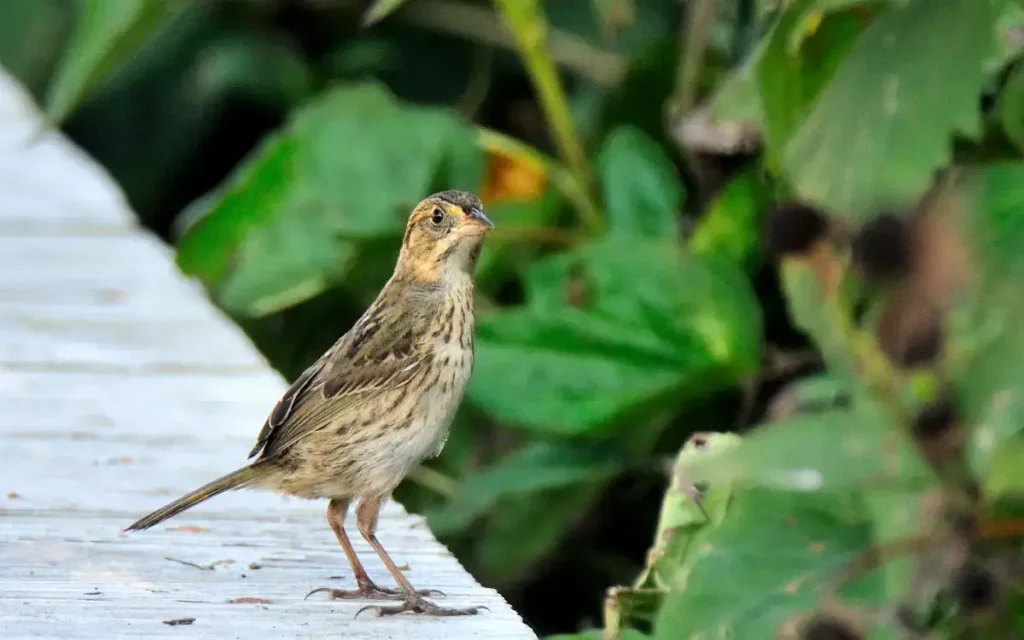
The Seaside Sparrow is adapted to coastal habitats, with a streaked plumage and subtle yellowish coloring. Its song, often described as a series of buzzes and trills, adds a coastal touch to marshes and wetlands.
Habitat and Behavior
Seaside Sparrows are commonly found in marshes, coastal wetlands, and estuaries. They feed on insects, small crustaceans, and plant material. These sparrows are known for their ability to forage in marshy vegetation.
Interesting Fact
Seaside Sparrows build their nests close to the ground in dense marsh vegetation, providing protection from tides and predators.
- Length: around 5 inches
- Weight: 0.7-1.0 oz (19-29 g)
- Wingspan: 5.1-7.9 inches
24. Lincoln’s Sparrow:

The Lincoln’s Sparrow features fine streaking on its plumage and a subtle buffy-colored chest. Its song, a mix of clear notes and trills, is often heard during the breeding season in wetlands and grassy areas.
Habitat and Behavior
Lincoln’s Sparrows inhabit wetlands, marshes, and brushy areas. They feed on insects, seeds, and small invertebrates. These sparrows are known for their secretive behavior, often remaining hidden in dense vegetation.
Interesting Fact
Lincoln’s Sparrows have a distinct migration pattern, often traveling along the Pacific Coast during migration.
- Length: 5.1-5.9 in (13-15 cm)
- Weight: 0.6-0.7 oz (17-19 g)
- Wingspan: 7.5-8.7 in (19-22 cm)
25. Swamp Sparrow:

The Swamp Sparrow boasts a charming combination of rusty plumage and intricate streaking. Its song, often described as a series of musical trills and buzzes, adds a melodic touch to marshes and wetlands.
Habitat and Behavior
Swamp Sparrows are commonly found in wetlands, marshes, and riparian areas. They feed on insects, small crustaceans, and plant material. These sparrows are known for their preference for dense vegetation.
Interesting Fact
Swamp Sparrows are known to engage in “wing flicking,” a behavior where they spread their wings and tail while singing.
- Length: 4.7-5.9 in (12-15 cm)
- Weight: 0.5-0.8 oz (15-23 g)
- Wingspan: 7.1-7.5 in (18-19 cm)
26. Nelson’s Sparrow:

Nelson’s Sparrow features a distinct combination of gray plumage and a buffy-colored chest. Its song, a mix of clear whistles and trills, adds an element of curiosity to marshes and wetlands.
Habitat and Behavior
Nelson’s Sparrows inhabit marshes, coastal wetlands, and grassy areas. They feed on insects, small crustaceans, and plant material. These sparrows are known for their preference for dense marsh vegetation.
Interesting Fact
Nelson’s Sparrows are known for their “teetering” behavior, where they sway back and forth on their perch while singing.
- Length: 4.3-5.1 in (11-13 cm)
- Weight: 0.6-0.7 oz (17-21 g)
- Wingspan: 6.5-7.9 in (16.5-20 cm)
Know more about – The world all species of Sparrows
FAQs about the 26 Species of Sparrows in California:
Q: Where can I find the most diverse species of sparrows in California?
A: California’s diverse landscapes, including grasslands, marshes, and desert scrublands, host a wide variety of sparrow species.
Q: What is the distinctive feature of the Black-throated Sparrow?
A: The Black-throated Sparrow is known for its unique black throat patch, which sets it apart from other sparrows.
Q: How can I attract sparrows to my backyard?
A: Providing a mix of seeds, insects, and appropriate shrubbery can attract sparrows to your garden.
Q: Are sparrows migratory birds?
A: Many sparrows are migratory, with some species traveling great distances during migration.
Q: What is the significance of sparrows in California’s ecosystem?
A: Sparrows play a vital role in controlling insect populations and dispersing plant seeds, contributing to ecosystem health.
Q: How can I differentiate between the subspecies of Bell’s Sparrow?
A: Subspecies of Bell’s Sparrow differ in their plumage characteristics, with each having a unique appearance.
Conclusion:
California’s sparrows are Different and interesting, playing crucial roles in their ecosystems. Learning about these birds helps us appreciate and protect our natural world.

